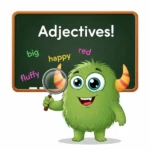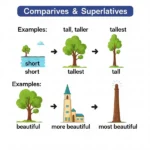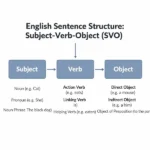Adverbs: Your Secret Weapon for More Exciting English!
What is an Adverb?
Have you ever wondered how to make your sentences more descriptive and interesting? Well, get ready to meet your new best friend: adverbs! Think of adverbs as the “spice” for your sentences. They add flavor and detail, helping you paint a clearer picture with your words. In this article, we’ll break down what an adverb is, how to use them, when to use adverbs and give you tons of examples to help you master them. Learn more about what is an adverb and how to use them in sentences.
You may be using adverbs without knowing it. It is important that you know the difference between using adverbs vs. using adjectives. Many people use an adjective in their sentence when they should be using an adverb. For example, a popular sentence is “I feel good”, which is not correct, the correct sentence is “I feel well”. Why? because “feel” is a verb and you don’t use adjectives to describe verbs, you use adverbs. The word “good” is an adjective while “well” is an adverb. What is an adverb? Study this page more to learn more about how to use adverbs.
What in the World is an Adverb?
An adverb is a word that describes or gives more information about:
- A verb: It tells us how, when, where, why, to what extent, or how often an action happens.
- An adjective: It tells us how much or to what degree something is.
- Another adverb: It tells us how or to what degree another adverb is modifying something.
- An entire sentence: It gives an overall comment about the sentence.
Don’t worry if that sounds like a lot right now. We’ll look at each one with examples!
Adverbs describe verbs in the same way as adjectives describe nouns.
You can describe a noun using an adjective – beautiful girl – “beautiful” is the adjective, and “girl” is the noun (Adjectives)
Refresh your knowledge about verbs with this lesson – Verbs, What are they and how to use them?
Think of it this way:
- Verbs are the “doing” words (run, eat, sing).
- Adverbs tell you how you run, when you eat, or where you sing.
How Do I Use Adverbs? (The Four Main Jobs of Adverbs)
Let’s explore the different ways adverbs work their magic.
1. Adverbs Modifying Verbs (The Most Common Job!)
This is where adverbs shine! When to use adverbs? When you want to tell us more about the action in a sentence.
Examples:
- How? (Manner)
- She sings beautifully. (How does she sing? Beautifully.)
- He runs quickly. (How does he run? Quickly.)
- They work hard. (How do they work? Hard.)
- When? (Time)
- I will go to the market tomorrow. (When will I go? Tomorrow.)
- She arrived early. (When did she arrive? Early.)
- We eat dinner daily. (When do we eat dinner? Daily.)
- Where? (Place)
- Please come here. (Where should you come? Here.)
- The cat is sleeping underneath. (Where is the cat sleeping? Underneath.)
- They live abroad. (Where do they live? Abroad.)
- How Often? (Frequency)
- I always brush my teeth. (How often do I brush? Always.)
- She rarely eats fast food. (How often does she eat? Rarely.)
- We sometimes go to the beach. (How often do we go? Sometimes.)
- To What Extent? (Degree/Intensity)
- He almost finished his homework. (To what extent did he finish? Almost.)
- She really likes ice cream. (To what extent does she like it? Really.)
- The movie was quite good. (To what extent was it good? Quite.)
Chart: Adverbs Modifying Verbs
| Type of Adverb | Question it Answers | Example Adverbs | Example Sentence |
| Manner | How? | slowly, loudly, carefully, well, happily | She walks slowly. |
| Time | When? | now, yesterday, soon, later, always | He will come soon. |
| Place | Where? | here, there, outside, upstairs, nearby | The dog is outside. |
| Frequency | How Often? | always, never, often, sometimes, usually | I often read books. |
| Degree | To what extent? | very, really, almost, quite, too, enough | It’s very hot today. |
2. Adverbs Modifying Adjectives
Adverbs can also make adjectives even stronger or more specific. They tell us how much or to what degree something has a certain quality.
Examples:
- The dog is extremely cute. (How cute? Extremely cute.)
- She is very happy. (How happy? Very happy.)
- The food was really delicious. (How delicious? Really delicious.)
- He is quite tall. (How tall? Quite tall.)
Chart: Adverbs Modifying Adjectives
| Adverb Example | Adjective it Modifies | Meaning |
| extremely | cute | very, very cute |
| very | happy | a lot of happiness |
| really | delicious | truly delicious |
| quite | tall | fairly tall |
3. Adverbs Modifying Other Adverbs
Yes, adverbs can even describe other adverbs! This makes the description even more precise.
Examples:
- He runs very quickly. (How quickly? Very quickly.)
- She sings quite beautifully. (How beautifully? Quite beautifully.)
- They finished the task almost perfectly. (How perfectly? Almost perfectly.)
Chart: Adverbs Modifying Other Adverbs
| Adverb 1 Example | Adverb 2 it Modifies | Meaning |
| very | quickly | to a high degree of quickness |
| quite | beautifully | to a fair degree of beauty |
| almost | perfectly | nearly perfectly |
4. Adverbs Modifying an Entire Sentence (Sentence Adverbs)
These adverbs comment on the whole sentence, expressing the speaker’s opinion or attitude.
Examples:
- Fortunately, we found our lost keys. (It was fortunate that we found them.)
- Clearly, he is upset. (It’s clear that he is upset.)
- Hopefully, it will rain tomorrow. (I hope it will rain tomorrow.)
- Certainly, you can come with us. (I am sure you can come.)
Chart: Sentence Adverbs
| Sentence Adverb Example | Meaning / Speaker’s Attitude |
| Fortunately | It is lucky / good luck |
| Clearly | It is obvious / evident |
| Hopefully | I hope that… |
| Certainly | Without a doubt / absolutely |
Where Do I Put Adverbs in a Sentence? (Word Order)
The position of an adverb can sometimes change its meaning, but for beginners, here are some common and easy rules:
- Adverbs of Manner: Usually go after the verb or after the object if there is one.
- She sings beautifully.
- He plays the piano well.
- Adverbs of Time and Place: Usually go at the end of the sentence or at the beginning for emphasis.
- I will go to the park tomorrow.
- Yesterday, I saw a bird.
- The book is here.
- Adverbs of Frequency: Usually go before the main verb but after “be” verbs (am, is, are, was, were).
- I always drink coffee.
- She is never late.
- Adverbs of Degree: Usually go before the adjective or the adverb they modify.
- It’s very cold.
- He walks too fast.
- Sentence Adverbs: Usually go at the beginning of the sentence, often followed by a comma.
- Luckily, we caught the bus.
Common Adverb Endings (-ly)
Many adverbs are formed by adding -ly to an adjective. This is a great tip for recognizing them!
Adjective + -ly = Adverb
| Adjective | Adverb |
| quick | quickly |
| beautiful | beautifully |
| careful | carefully |
| happy | happily |
| soft | softly |
Important Note: Not all adverbs end in -ly (e.g., well, fast, always, here, now). Also, some words ending in -ly are adjectives (e.g., friendly, lovely). You’ll learn these exceptions as you practice!
200 Most Common Adverbs
|
Now |
Then |
So |
Very |
Too |
|
Never |
Always |
Ever |
Seldom |
Rarely |
|
Gradually |
Eventually |
Monthly |
Weekly |
Yearly |
|
Annually |
Quarterly |
Much |
Most |
Quickly |
|
Slowly |
Incidentally |
Immediately |
Simultaneously |
Happily |
|
Sadly |
Frequently |
Commonly |
Sincerely |
Faithfully |
|
Sweetly |
Badly |
Dearly |
Patiently |
Mostly |
|
Silently |
Willingly |
Hardly |
Often |
Daily |
|
Occasionally |
Regularly |
Normally |
Actually |
Basically |
|
Here |
There |
Yesterday |
Today |
Tomorrow |
|
Arguably |
Comparatively |
Consecutively |
Honestly |
Truthfully |
|
Lovingly |
Perfectly |
Highly |
Likely |
Nearly |
|
Barely |
Far |
Least |
Deeply |
Fully |
|
Completely |
Casually |
Tastefully |
Madly |
Purely |
|
Privately |
Publicly |
Towards |
Inside |
Outside |
|
Upstairs |
Downstairs |
Uphill |
Downhill |
Everywhere |
|
Somewhere |
Nowhere |
Anywhere |
Eagerly |
Beautifully |
|
Proudly |
Elegantly |
Confidently |
Incessantly |
Boldly |
|
Carefully |
Cautiously |
Carelessly |
Easily |
Awkwardly |
|
Nearby |
Cheerfully |
Abruptly |
Late |
Everyday |
|
Soon |
Coldly |
Angrily |
Curiously |
Noisily |
|
Loudly |
Earnestly |
Interestingly |
Readily |
Vaguely |
|
Unwillingly |
Obediently |
Rapidly |
Continuously |
Consciously |
|
Instinctively |
Boldly |
Brightly |
Cunningly |
Suitably |
|
Appropriately |
Currently |
Doubtfully |
Ambiguously |
Momentarily |
|
Early |
Last week |
Last month |
Last year |
Later |
|
Northwards |
Southwards |
Eastwards |
Westwards |
Forward |
|
Backwards |
Away |
In |
Out |
Under |
|
Below |
Above |
Abroad |
North |
South |
|
West |
East |
Southeast |
Southwest |
Northeast |
|
Northwest |
Up |
Down |
Underneath |
Gently |
|
Superficially |
Supremely |
Adequately |
Comfortably |
Conveniently |
|
Generously |
Briefly |
Accidentally |
Fiercely |
Fearfully |
|
Gracefully |
Graciously |
Busily |
Randomly |
Joyously |
|
Mysteriously |
Joyfully |
Poorly |
Repeatedly |
Seriously |
|
Smoothly |
Promptly |
Roughly |
Successfully |
Sufficiently |
|
Skillfully |
Sceptically |
Differently |
Physically |
Psychologically |
|
Logically |
Analytically |
Graphically |
Tightly |
Loosely |
|
Unexpectedly |
Tactfully |
Lazily |
Tremendously |
Vicariously |
|
Vividly |
Cleverly |
Victoriously |
Widely |
Well |
|
Purposefully |
Wisely |
Properly |
Sickly |
Legally |
|
Nicely |
Legibly |
Thoroughly |
Shortly |
Simply |
|
Tidily |
Necessarily |
Tenaciously |
Strongly |
Humbly |
|
Consequently |
Similarly |
Unlikely |
Possibly |
Probably |
Why Are Adverbs So Important?
Using adverbs effectively can significantly improve your English communication, making your writing and speaking:
- More Expressive: Instead of just “He ran,” you can say “He ran quickly” or “He ran frantically.” This adds emotion and detail.
- More Precise: Adverbs help you specify exactly how, when, or where something happened.
- More Engaging: Varied sentence structure and detailed descriptions keep your reader or listener interested.
When you use adverbs well, your English will sound more natural and sophisticated, demonstrating your growing expertise and making your communication more trustworthy.
Helpful Tips for Beginner English Students:
- Start Simple: Don’t try to use too many complicated adverbs at first. Focus on the common ones like very, really, quickly, slowly, now, here.
- Read and Listen: Pay attention to how native speakers use adverbs in books, movies, and conversations. This will help you get a feel for their natural placement.
- Practice, Practice, Practice: The more you use adverbs, the more comfortable you’ll become. Try writing short sentences and then adding adverbs to make them more interesting.
- Use a Dictionary: If you’re unsure if a word is an adverb or how to use it, look it up! Most dictionaries will tell you the word type.
Ready for a Little Practice?
Try to add an adverb to each of these sentences to make them more descriptive:
- The bird sang.
- She walked.
- I woke up.
- The cake was good.
(Think about how, when, or where!)
Here is a PDF worksheet you can download with 25 sentences you can practice choosing an Adverb. Answers are on a separate sheet.
Additional Helpful Information
Some details about verbs – What are Verbs? How to use Verbs When Speaking English?
Refresh your memory about adjectives – Learning About Adjectives: English for Beginner Students
Authoritative External Links for More Learning:
To deepen your understanding, here are some excellent resources from trusted English language experts:
- Purdue OWL (Online Writing Lab) – Adverbs: A comprehensive guide for all levels.
- British Council – Adverbs: Great explanations and examples, often with exercises.
- Cambridge Dictionary – Grammar (Adverbs): Reliable definitions and usage notes.
By using adverbs, you’re not just adding words; you’re adding color, emotion, and precision to your English. Keep practicing, and soon you’ll be using adverbs like a pro! Happy learning!




